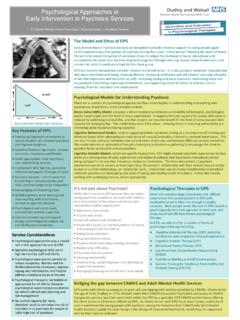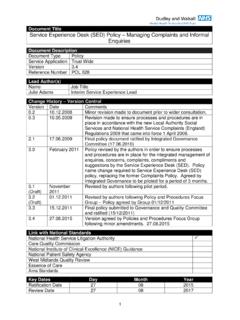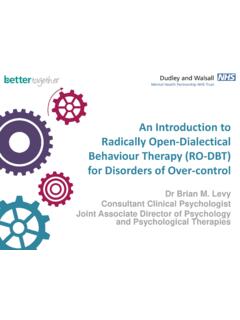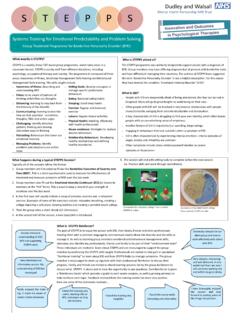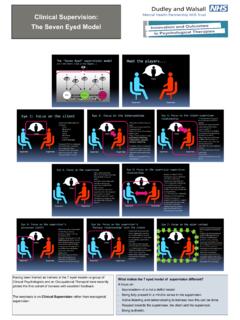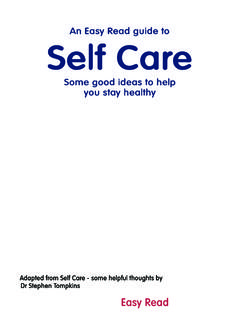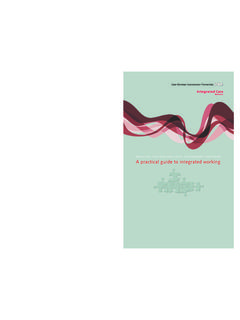Transcription of Cognitive Analytic Therapy - Mental Health …
1 Cognitive Analytic Therapy A Psychological Model for Working Directly and Indirectly with Clients with Complex Problems Dr Daniella Wickett, Clinical Psychologist and Trainee CAT Practitioner What is Cognitive Analytic Therapy ? Developed by Dr Anthony Ryle in the late 1980's specifically with the needs of the NHS in mind, CAT. is an integrative model of psychological Therapy . It draws on Cognitive , psychoanalytic, and social learning theories/approaches. CAT offers an individualised approach within a time limited framework that is appropriate for a wide range of psychological problems, with particular value for complex emotional and relational difficulties ( personality disorders). CAT aims to help people to understand the origins of their distress, which are often be rooted in early experiences, and how their difficulties may be maintained by the ways that they have learned to cope or to manage their problems, feelings and needs. CAT can be used as a model for individual Therapy , with couples and groups, and also can play a What does CAT involve?
2 CAT as a Consultation Approach CAT is usually offered as a 16 or 24 session Therapy . CAT can be used in supervision and consultation. It can be offered as a shorter or longer Therapy Staff, teams, and/or families can benefit from Key Elements of CAT. depending on complexity of the client and their discussing or jointly developing a CAT formulation Active and collaborative ability to engage in psychological work. diagram for clients. A typical 16 session CAT would involve: Relational approach problems seen The aim is to increase understanding and as a consequence of learned ways of Sessions 1-4: understanding problems and compassion for the client, and awareness of the relating, which are repeated in our previous history; a formulation letter written (and client's patterns of relating that others can get relationships with others and ourselves read aloud) to the client caught up in ( responding automatically to the client's difficult behaviour or distress, which may Working within clients' current Sessions 5-12: developing a formulation diagram; psychological capability to increase inadvertently reinforce unhelpful patterns ).
3 Use of formulation tools and diaries to aid their ability to self-reflect and make recognition of unhelpful patterns; and developing The formulation diagram takes into account the sense of themselves, their feelings and exits (revision) from these patterns coping client's history, current problems and direct their actions strategies, new ways of relating experiences of being with' the client. The diagram represents relationship patterns and ways of coping Considering the significance of past Sessions 13-16: on-going work of Therapy plus an experience and relationships but also that may maintain the client's problems and distress. explicit focus on ending Therapy and loss; goodbye focusing on current problems and It can help to explain why some interventions may letters read aloud and exchanged relationship patterns not be helping or why the client and/or worker may Follow-up at 3 months for review feel stuck. Central role of individualised formulation letters and diagrams.
4 Example of a CAT Critical, rejecting, blaming, controlling Unmet Needs offering validation for the client, Demanding, threatening, enhancing engagement in Therapy , Formulation Diagram Not good enough, pushed out, unloved, Feeling unloved, absence of affection, feeling unwanted, not feeling accepted as part of the family aggressive enabling recognition and revision of insecure Understanding the diagram: Stressed anxious, fearful unhelpful patterns, and helping to The square boxes represent patterns anticipate and resolve potential threats of relating to self and others (each Feel angry and upset but fear being rejected, so try to not to Unmanageable Feelings Threaten to or try to harm myself or to Therapy Explicitly addresses issues of ending end my life, try to seek love and care operating in opposite positions) show my anger Anxious, low, sad, lonely, unloved, insecure, guilty, regretful, in ways that others find hard to cope The red loop represents a coping angry, jealous, alone, invisible with and loss.
5 Use of goodbye letters from pattern of trying to please to seek Want family together, want to feel loved, wanted and safe both therapist and client Difficult to verbally care or avoid rejection communicate feelings and needs The blue loop represents a coping Try hard to please others, pattern of seeking idealised care be nice, make jokes to be accepted Ideally loving and Others walk away, I. feel rejected Family try to be careful with me, give me Service Considerations caring through intense attachment what I want, reduce demands on me, offer reassurance, The green loop represents a coping display concern pattern of threatening as a way of Efforts not enough/. good enough Loved and cared for, special, wanted, safe CAT is an effective, time-limited model communicating feelings and needs Feeling doesn't last, others make demands or place limits on me, feel of Therapy that can be used with a rejected by others No-one wide range of emotional difficulties The aim of Therapy is to learn to recognise unhelpful Intensely attached, fearful of Alone, unloved, including complex problems and patterns and to find exits out of these patterns or develop loss, over-protective Others find it overwhelming invisible personality disorders new ways of relating to self and others (revision).
6 It can be used indirectly to support team-working and care planning, and What Clients Say About CAT Benefits of Team CAT Formulation can help to reduce staff stress CAT has changed the way I am trying to live my life' Increases psychological knowledge and skill in teams and It is not a panacea and requires My wife feels that the old me' is coming back' increases clients' access to a psychologically-informed approach clients to be willing to think and talk I will keep it (the letter) forever, as a reminder to myself' Offers space for reflection that helps staff to feel supported, about problems and relationships valued, and validated It's like a weight off my shoulders; I knew that you were Staff have a better understanding of the client and greater To offer effective CAT Therapy or listening and I felt heard'. empathy for the client's difficulties and distress supervision, professionals need to be I didn't think that I could ever think or feel differently but Staff understand their role better and feel more contained, trained to at least Practitioner' level thanks to the work we have done, I understand now that perfect isn't 'm ok with that'.
7 Confident and motivated in their approach, and less frustrated (Post Graduate Diploma in CAT). in the face of difficulties or lack of progress I understand the patterns that I have with people and the Staff are more aware of their own reactions/responses to Growing evidence base but currently way that I deal with things that will help me in the few Randomised Control Trials clients' distress and behaviour, and are less likely to act (or be process of changing to make them healthier connections'. drawn into responding) in unintentionally unhelpful ways
